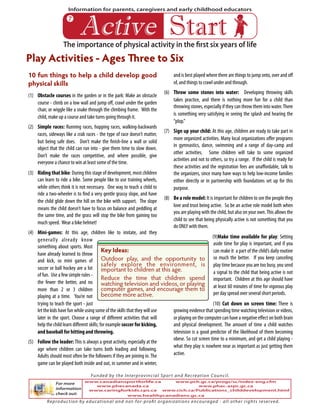
Importance of physical activity for young children
- 1. The importance of physical activity in the first six years of life Information for parents, caregivers and early childhood educators !"#$%& '#()# 10 fun things to help a child develop good physical skills (1) Obstacle courses in the garden or in the park: Make an obstacle course - climb on a low wall and jump off, crawl under the garden chair, or wiggle like a snake through the climbing frame. With the child, make up a course and take turns going through it. (2) Simple races: Running races, hopping races, walking-backwards races, sideways like a crab races - the type of race doesn’t matter, but being safe does. Don’t make the finish-line a wall or solid object that the child can run into - give them time to slow down. Don’t make the races competitive, and where possible, give everyone a chance to win at least some of the time. (3) Riding that bike: During this stage of development, most children can learn to ride a bike. Some people like to use training wheels, while others think it is not necessary. One way to teach a child to ride a two-wheeler is to find a very gentle grassy slope, and have the child glide down the hill on the bike with support. The slope means the child doesn’t have to focus on balance and peddling at the same time, and the grass will stop the bike from gaining too much speed. Wear a bike helmet! (4) Mini-games: At this age, children like to imitate, and they generally already know something about sports. Most have already learned to throw and kick, so mini games of soccer or ball hockey are a lot of fun. Use a few simple rules - the fewer the better, and no more than 2 or 3 children playing at a time. You’re not trying to teach the sport - just let the kids have fun while using some of the skills that they will use later in the sport. Choose a range of different activities that will help the child learn different skills; for example soccer for kicking, and baseball for hitting and throwing. (5) Follow the leader:This is always a great activity, especially at the age where children can take turns both leading and following. Adults should most often be the followers if they are joining in.The game can be played both inside and out, in summer and in winter, and is best played where there are things to jump onto, over and off of, and things to crawl under and through. (6) Throw some stones into water: Developing throwing skills takes practice, and there is nothing more fun for a child than throwing stones, especially if they can throw them into water.There is something very satisfying in seeing the splash and hearing the “plop.” (7) Sign up your child: At this age, children are ready to take part in more organized activities. Many local organizations offer programs in gymnastics, dance, swimming and a range of day-camp and other activities. Some children will take to some organized activities and not to others, so try a range. If the child is ready for these activities and the registration fees are unaffordable, talk to the organizers, since many have ways to help low-income families either directly or in partnership with foundations set up for this purpose. (8) Be a role model: It is important for children to see the people they love and trust being active. So be an active role model both when you are playing with the child, but also on your own.This allows the child to see that being physically active is not something that you do ONLY with them. (9)Make time available for play: Setting aside time for play is important, and if you can make it a part of the child’s daily routine so much the better. If you keep canceling play time because you are too busy, you send a signal to the child that being active is not important. Children at this age should have at least 60 minutes of time for vigorous play per day spread over several short periods. (10) Cut down on screen time: There is growing evidence that spending time watching television or videos, or playing on the computer can have a negative effect on both brain and physical development. The amount of time a child watches television is a good predictor of the likelihood of them becoming obese. So cut screen time to a minimum, and get a child playing - what they play is nowhere near as important as just getting them active. Play Activities - Ages Three to Six ! Key Ideas: Outdoor play, and the opportunity to safely explore the environment, is important to children at this age. Reduce the time that children spend watching television and videos, or playing computer games, and encourage them to become more active. For more information check out: Reproduction by educational and not-for-profit organizations encouraged - all other rights reserved. Funded by the Interprovincial Sport and Recreation Council. www.canadiansportforlife.ca www.phecanada.ca www.caringforkids.cps.ca www.healthycanadians.gc.ca www.pch.gc.ca/progs/sc/index-eng.cfm www.phac-aspc.gc.ca www.cich.ca/Publications_childdevelopment.html